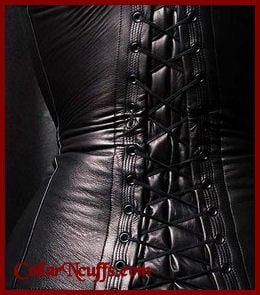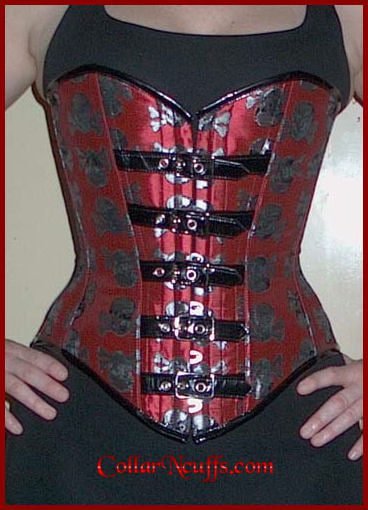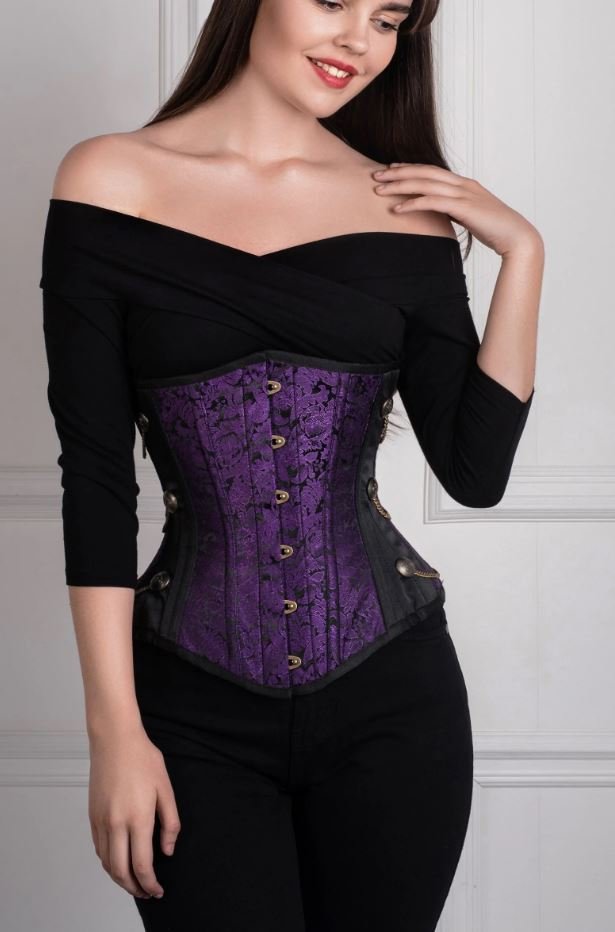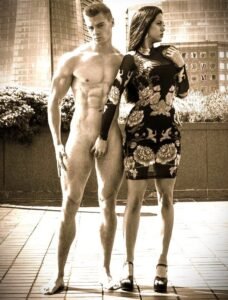
Table of Contents
What is a Corset and what isn’t?
A corset is a garment worn to mold and shape the torso into a desired shape for aesthetic or medical purposes (either for the duration of wearing it, or with a more lasting effect). Both men and women are known to wear corsets, though women are more common wearers.
Many garments sold as “corsets” during recent years are not technically corsets in the traditional sense. While modern “corsets” and “corset tops” often feature lacing and/or boning and generally mimic a historical style of corsets, they have very little if any effect on the shape of the wearer’s body.
In recent years, the term “corset” has also been borrowed by the fashion industry to refer to tops which, to varying degrees, mimic the look of traditional corsets without actually acting as one; such tops are frequently seen in stores which cater to fans of gothic fashion. Many such tops feature lacing or boning and are fairly tight-fitting; however, genuine corsets are usually made by a corsetmaker and should ideally be fitted especially for the individual
The word corset is derived from the Old French word cors , the diminutive of body, which itself derives from corpus – the Latin for body
The most common and well-known use of corsets is to slim the body and make it conform to a fashionable silhouette. For women this most frequently emphasizes a curvy figure, by reducing the waist, and thereby exaggerating the bust and hips . However, in some periods, corsets have been worn to achieve a tubular straight-up-and-down shape, which involves minimizing the bust and hips.
For men, corsets are more customarily used to slim the figure. However, there was a period from around 1820 to 1835 when an hourglass figure (a small, nipped-in look to the waist) was also desirable for men; this was sometimes achieved by wearing a corset.

An overbust corset encloses the torso, extending from just under the arms to the hips.

An underbust corset begins just under the breasts and extends down to the hips.
Some corsets extend over the hips and, in very rare instances, reach the knees A shorter kind of corset, which covers the waist area (from low on the ribs to just above the hips), is called a ‘waist cincher’. A corset may also include garters to hold up stockings (alternatively a separate garter belt may be worn for that). Normally a corset supports the visible dress, and spreads the pressure from large dresses, such as the crinoline and bustle. Sometimes a corset cover is used to protect outer clothes from the corset and to smooth the lines of the corset.
Medical Corsets
People with spinal problems such as scoliosis or with internal injuries may be fitted with a form of corset in order to immobilize and protect the torso. However, this may be harmful if not medically indicated. Andy Warhol was shot in 1968 and never fully recovered, and wore a corset for the rest of his life.
Fetish Corsets
Aside from fashion and medical uses, corsets are also used in sexual fetishism, most notably in BDSM activities. In BDSM, a submissive can be forced to wear a corset which would be laced very tight and give some degree of restriction to the wearer. A dominant can also wear a corset, often black, but for entirely different reasons, such as aesthetics, and to achieve a severe, armored, “unbending,” commanding appearance.
Construction of Corsets
Corsets are typically constructed of a flexible material (like cloth, particularly coutil, or leather) stiffened with boning (also called ribs or stays) inserted into channels in the cloth or leather. In the 19th century, steel and whalebone were favored for the boning. Featherbone was used as a less expensive substitute for whalebone and was constructed from flattened strips of goose quill woven together with yarn to form a long strip (Doyle, 1997:232). Plastic is now the most commonly used material for lightweight corsets, whereas spring or spiral steel is preferred for stronger corsets. Other materials used for boning include ivory, wood, and cane. (By contrast, a girdle is usually made of elasticized fabric, without boning.) The craft of corset construction is known as corsetry, as is the general wearing of them. Someone who makes corsets is a corsetier or corsetière (French terms for a man and for a woman, respectively), or sometimes simply a corsetmaker (The word corsetry is sometimes also used as a collective plural form of corset.)
Corsets are held together by lacing, usually (though not always) at the back. Tightening or loosening the lacing produces corresponding changes in the firmness of the corset. Depending on the desired effect and time period, corsets can be laced from the top down, from the bottom up, or both up from the bottom and down from the top, using two laces that meet in the middle. It is difficult – although not impossible – for a back-laced corset-wearer to do his or her own lacing. In the Victorian heyday of corsets, a well-to-do woman would be laced by her maid, and a gentleman by his valet. However, many corsets also had a buttoned or hooked front opening called a busk. Once the lacing was adjusted comfortably, it was possible to leave the lacing as adjusted and take the corset on and off using the front opening (this method can potentially damage the busk if the lacing is not significantly loosened beforehand). Self-lacing is also almost impossible with tightlacing, which strives for the utmost possible reduction of the waist. Modern tightlacers, lacking servants, are usually laced by spouses and partners.
Waist reduction Corseting
By wearing a tightly-laced corset for extended periods, known as tightlacing (external Wiki link http://en.wikipedia.org/wiki/Tightlacing), men and women can learn to tolerate extreme waist constriction and eventually reduce their natural waist size. Tightlacers dream of 40 to 43 centimeters (16 to 17 inches) waists, but most are satisfied with anything under 50 centimeters (20 inches). Until 1998, the Guinness Book of World Records listed Ethel Granger (external link) as having the smallest waist on record at 32.5 centimeters (13 inches). After 1998, the category changed to “smallest waist on a living person” and Cathie Jung took the title with a 37.5 centimeters (15 inches) waist. Other women, such as Polaire, also have achieved such reductions (14 inches in her case). These are extreme cases, however. Corsets were and are still usually designed for support, with freedom of body movement an important consideration in their design. Present day corset-wearers usually tighten the corset just enough to reduce their waists by 5 to 10 centimeters (2 to 4 inches); it is very difficult for a slender woman to achieve as much as 15 centimeters (6 inches), although larger women can do so more easily.
Corset comfort
In the past, a woman’s corset was usually worn over a garment called a chemise or shift a sleeveless low-necked gown made of washable material (usually cotton or linen). It absorbed perspiration and kept the corset and the gown clean. In modern times, an undershirt or corset liner may be worn.
Moderate lacing is not incompatible with vigorous activity. Indeed, during the second half of the nineteenth century, when corset wearing was common, there were sport corsets specifically designed to wear while bicycling, playing tennis, or horseback riding, as well as for maternity wear.
Many people now believe that all corsets are uncomfortable and that wearing them restricted women’s lives, citing Victorian literature devoted to sensible or hygienic dress. However, these writings generally protested against the misuse of corsets for tightlacing; they were less vehement against corsets per se. Many reformers recommended “Emancipation bodices”, which were essentially tightly-fitted vests, like full-torso corsets without boning. . Some modern day corset-wearers will testify that corsets can be comfortable, once one is accustomed to wearing them. A properly fitted corset should be comfortable. Women active in the historical re enactment groups commonly wear corsets as part of period costume, without complaint
Modern history of Corsetry
The corset fell from fashion in the 1920s in Europe and America, replaced by girdles and elastic brassieres, but survived as an article of costume. Originally an item of lingerie, the corset has become a popular item of outerwear in the fetish, BDSM and goth subcultures. In the fetish and BDSM literature, there is often much emphasis on tightlacing . In this case, the corset may still be underwear rather than outerwear.
There was a brief revival of the corset in the late 1940s and early 1950s, in the form of the waist cincher sometimes called a “waspie”. This was used to give the hourglass figure dictated by Christian Dior’s ‘New Look’. However, use of the waist cincher was restricted to haute couture, and most women continued to use girdles. This revival was brief, as the New Look gave way to a less dramatically-shaped silhouette.
Since the late 1980s, the corset has experienced periodic revivals, which have usually originated in haute couture and which have occasionally trickled through to mainstream fashion. These revivals focus on the corset as an item of outerwear rather than underwear. The strongest of these revivals was seen in the Autumn 2001 fashion collections and coincided with the release of the film Moulin Rouge!, the costumes for which featured many corsets as characteristic of the era.
Similarly, other films have used these garments as costume features, generally to suggest a period effect, as in Van Helsing, where Anna Valerious (Kate Beckinsale) wears an ornate underbust corset as part of her costume. Sometimes this is used for humorous purposes, as when in Pirates of the Caribbean: The Curse of the Black Pearl Elizabeth Swann (Keira Knightley) almost suffocates from wearing a tight corset. One distinctive feature has been to portray them in combination with catsuits, as in Star Trek: Voyager where Seven of Nine (Jeri Ryan) throughout the series wears catsuits with contained built-in corsets, or Underworld, where Selene (Kate Beckinsale) wears a black leather corset over matching latex catsuit
The majority of garments sold as “corsets” (or sometimes “corset tops”) during these recent revivals cannot really be counted as corsets at all, in the traditional sense of the word. While they often feature lacing and boning and generally mimic a historical style of corsets, they have little or no effect on the shape of the wearer’s body; traditional corsets generally require custom fitting by a tailor who specialises in corsetry.
A corset dress (also known as hobble corset because it produces similar restrictive effects to a hobble skirt) is a long corset. It is like an ordinary corset, but it is long enough to cover the legs, partially or totally. It thus looks like a dress, hence the name. A person wearing a corset dress can have great difficulty in walking up and down the stairs (especially if wearing high-heeled footwear) and may be unable to sit down if the boning is too stiff.
Advantages and disadvantages of corsets
Advantages
- Health benefits
- Corsets promote good posture.
- Corsets can reduce pain and improve function for people with back problems or other muscular/skeletal disorders, such as Lordosis Some large-breasted women find corsets more comfortable than brassieres, because the weight of the breasts is carried by the whole corset rather than the brassiere’s shoulder straps. Straps can chafe or cut the skin. However, if a bra is properly fitted, the weight of the breasts is carried by the band and not by the shoulders, thus eliminating this problem for even women with very large breasts.
- Personal, social and aesthetic advantages
- Corsets can give a straight masterful posture
- The straight posture accentuates the bosom.
- corsets can instantly reduce the waistline by 5-10cm (2-4“).
- Corsets can spread the weight of big gowns.
- The corsets can show social status, as the corset-wearers are different from other people. In the old days, the upper-class wore corsets to demonstrate distinction from lower classes. Today, some subcultures wear corsets to demonstrate nonconformity.
- Some corset-wearers enjoy the feeling of being “hugged” by the corset. Due to their tightness and close proximity to the body, corsets can make the wearer feel very warm. They have historically been worn in cooler climates.Some corset-wearers believe the shallow breathing imposed by the garment may charm men.
Long-term advantages of wearing Corsets
- The abdominal pressure maintained by frequent corset use can help wearers reduce body fat by inhibiting the appetite without conscious dieting, slimming drugs, or cosmetic surgery.
- Training with corsets can reduce waistline by 18cm (7”) or more.
Disadvantages of corsets
- Many corset design have difficulty by the correct lift of the chest, on beginners. This example is breaking the ribs on the middle, opposite the correct redresseur corset (external wiki link http://en.wikipedia.org/wiki/Redresseur_corset) which bend the ribs up close at the spine.
Health risks with courestry
The use of corsets have two basic risks. The compression of chest and pressure down of abdomen. If a corset is correct the chest been immediately high and broad in corset, in the same way as the chest been high and broad by a pregnancy, by the pressure from the womb. But many corsets have (especially for beginners) a serious problem with the amount of pressure exerted on the ribs and chest cavity. A correct corset is too big in the top, before it is tightened. Compression of the chest can lead to serious illness. Wearing a tight corset may lead to difficulty breathing. If a girl who has not yet developed wider hips uses a corset without a wasp waist or shoulder straps, the corset can only compress the chest. And all entrails will be moved together and down. Its and liver. Developing children are far more vulnerable to the potential health risks of corset use. As such, corsets should only be worn by fully-formed adults, never by growing children.
Risks: Pressure down of abdomen
In old days the abdomen was covered of skirts, and of that cause many cheap corsets end on the top of abdomen, and press it down. In the expensive corset the abdomen was supported by a stiff busk or sometimes front lace or a hip belt.
Risks: Corset by wasp waist
Wearing corsets by wasp waist over a long period of time may cause the lower ribs (floating ribs) to become deformed and pushed inwards. This can lead to broken ribs.
Difficulties finding a corset
Low-quality corsets. Finding a well-fitting, good-quality corset among the many imitations can be challenging. The potential wearer must try on and inspect any corset being considered for purchase for quality and fit. An ill-fitting corset will chafe, impede digestion, and ultimately cause damage to the ribs and pinch nerves.
The difficulties in getting used to corsets
Fainting. If the wearer is unaccustomed to shallow breathing,or if it is tied to tightly too quickly, the muscles soon tire and work too slowly, severely reducing oxygen supply. Would-be wearers must train up their breathing gradually. It is important that the corset lengthens the waist, like a redresseur corset (external wiki link), for better shallow breathing. A waist cincher is too short to accomplish this.
Beginning to wear a corset
Corsets must be broken in/molded to the owner’s body for the proper fit and reduction of stress on the seams that may lead to ripping. A corset must mold itself to the body of the wearer, so buying a custom corset is recommended. It takes a full day for a corset to mold to the wearers body. It is started by lacing the corset on loosely and tightening the laces every few hours at least. This allows the corset to gradually mold to the body using body heat, making an overall better feeling corset. One may even need to take off the corset and let it cool before resuming to mold it in order to have in mold better. It is highly unadvisable to wear someone else’s corset, as it is molded to their body and was made to fit them! Wearing a corset made for someone else may result in pain and cause the corset to unmold and cause the original wearer discomfort. If one is not a corset wearer, it may take up to a week to feel fully comfortable in a corset. That doesn’t mean that the corset should hurt, because it never should, it just may take up to a week for a corset to become less uncomfortable.
Corsets for beginners

After use of a starter corset, the lower ribs are turned up and can bear the pressure from a long-waisted corset. Corsets for beginners (also known as starter or beginner corsets) should be easy to adjust to for someone who has never been corseted, and give the correct position of the ribs. Three types of corsets are recommended for beginners:
The posture corset, which goes from the hip (close to the pubis) and has a moderate waist. All corsets from Spirella Co. were of this type.. The posture corset was a invention of madame Roxey A. Caplin from before 1856 and is common today.
The underbust hourglass corset for tightlacing, with a waist reduction of no more than 4“ unless the wearer’s initial waist is larger than 38”, in which case a 6“ reduction is acceptable. However, only a short wasp waist can fit a beginner. The underbust hourglass corset is a alternative fashion. Historical corsets specifically for beginners – pair of stays and redresseur corsets. Redresseur corsets fell out of fashion in 1919.
To be avoided by beginners:
Waist cinchers and waist training belts are not recommended, as they do not offer proper support of the stomach. Many historical corsets were designed with the assumption that wearers had used corsets for years, and so are harmful for beginners. The wasp waist in these corsets is too long, forcing the ribs to bend down rather than up as correct. Fashionable women of the past had a long waists; longer than modern natural waists.
Article: MissBonnie collarncuffs.com ©
Related Articles:







